Metal is a unique genre that uses low, muddled tones, intense power chords, and guitar distortion to create the aggressive sound millions of people love to headbang to. There are several branches of metal music that one can learn, from heavy metal to death metal, and each can be achieved using an electric guitar by keeping a few pointers in mind.
You can make an electric guitar sound better for metal using the right gear, strings and techniques. Adjusting your amp settings and incorporating pedals into the mix will also create the distorted sound that dominates the metal genre.
This article will look more closely at what gear is best to use, what amp settings are most appropriate and which techniques will make your electric guitar sound as metal as possible. Get ready to shred with the following tips!
👇😀👇NOTE👇😀👇
If you want to find out what my recommended guitar gear is, then here is what I recommend on Amazon:
- Fender Cutaway Acoustic-Electric Guitar Bundle (MY FAVORITE GUITAR)
- Snark SN-8 Super Tight All Instrument Tuner (Easiest Tuner I’ve Used😏)
- 6 String Acoustic Guitar Capo (Best CAPO for quick changes)
- Dunlop Max Grip 1.0mm Nylon Picks (Thick Guitar Pick So You Don’t Lose Grip!)
- Universal Guitar Stand (Cheap & Minimalist Guitar Stand I Recommend)
- Levy’s 2″ Wide Quick Adjust Guitar Strap (Best Guitar Strap For Any Level)
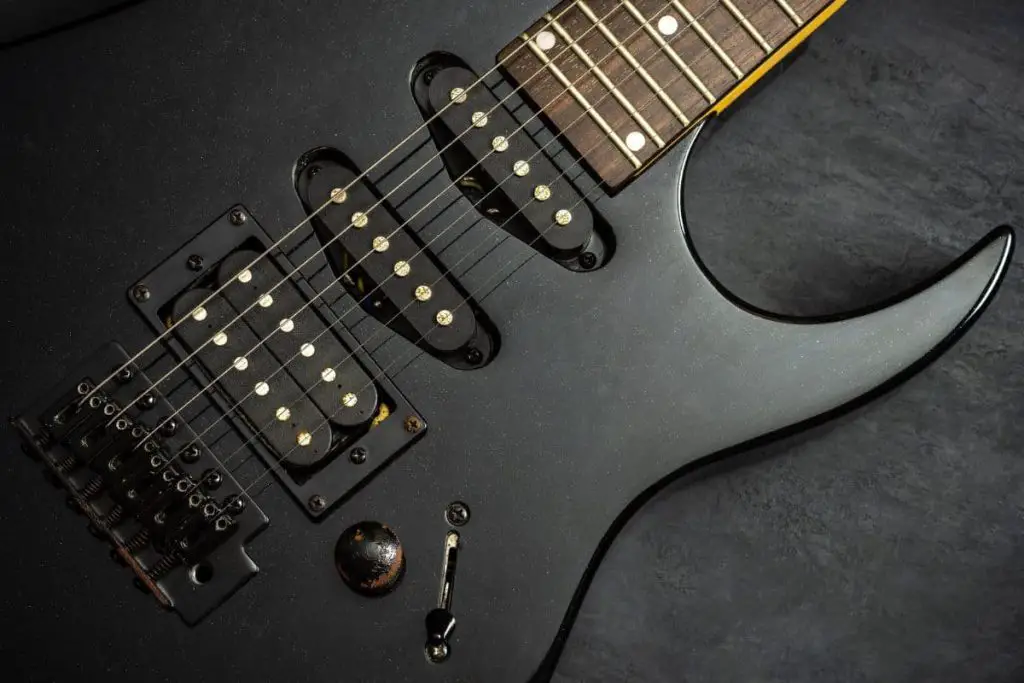
1. Use the Proper Gear
To achieve the best metal sound on your guitar, you want to ensure that you have the suitable gear. Specific instruments and amps are better designed to project the explosive riffs of metal, so it’s crucial that your equipment can withstand the power playing of the genre. Other pieces of equipment, like heavy-duty tuners and pickups, are also critical.
Best Amps for Metal Music
Metal music requires amps that can deliver a heavy tone; to achieve that, you need to buy an amp with gain control. Gain and volume work in tandem, with gain controlling the tone (clear versus distorted) and volume controlling the– well, the volume of the sound!
Paul Reed Smith MT 15
Also referred to as the ‘Lunchbox Hero,’ the Paul Reed Smith MT 15 is a small, low-wattage amp designed especially for metalheads. It hosts several gain stages (gain stages are the levels of sound prep before reaching the amp’s volume – read more here). This gives the guitar a much better metal sound because it creates a perfectly distorted tone.
Peavey 6505+
The Peavey 6505+ is the second-generation Peavey 6505 amp, surpassing its predecessor with durability, pure volume, and gain adjustments that deliver a wicked raw tone. The amp also comes with a foot pedal that allows you to adjust your amp settings and sound with a simple stomp of the foot.
Marshall DSL20C
Of course, I could never forget to include a Marshall’s amp. The DSL20C is an excellent amplifier for basically any genre of music, including metal. It has two groups of gain and volume settings (classic and ultra), and at 20 watts, it’s loud enough for parties and jam sessions.
Suppose you’re planning to play in a house show or in front of a big audience. In that case, you may want to consider upgrading to the DSL40, which has a higher wattage output and can reach the ears of larger crowds.
Best Guitars for Metal Music
So you’ve got a solid metal amp, but your instrument needs to be just as durable and strong! Now, a guitar doesn’t have to be big and flashy in order to play death metal. On the contrary, lightweight guitars are excellent for metal because they’re easy to hold and allow for fast fretting.
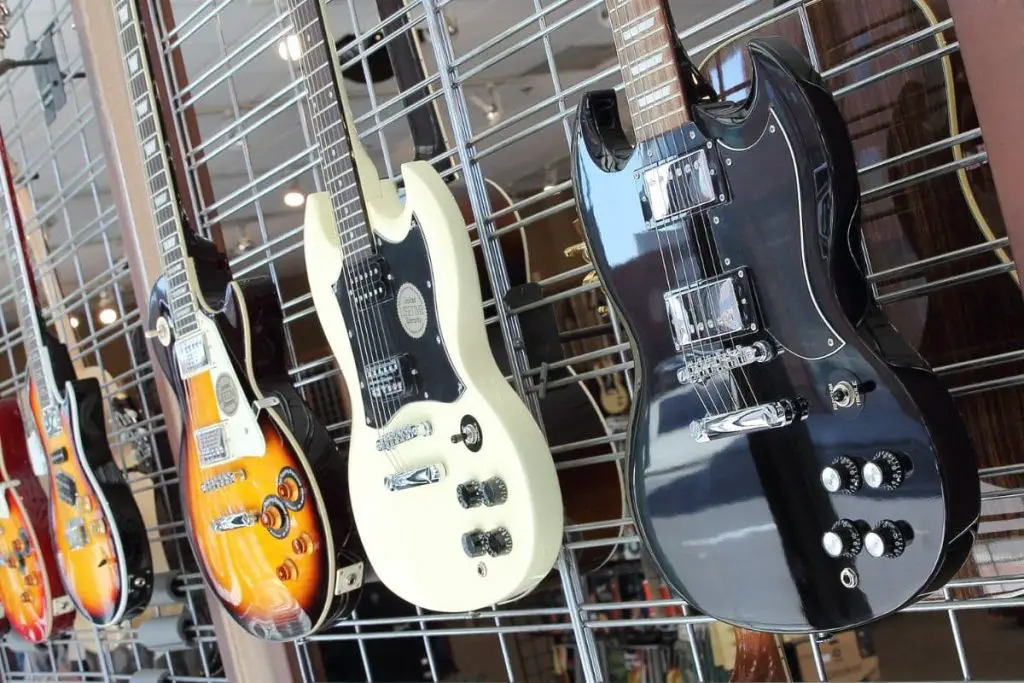
You might wonder what else makes a good metal guitar besides size. The best guitars for shredding have thin necks, locking tuners, and good pickups, as we’ll explore below. For now, let’s take a look at the best guitars to play for metal music.
Jackson X Series Rhoads RRX24
The Jackson X series is arguably the coolest looking shredder out there, with a sharp V shape to it. In reality, though, any of the Jackson series guitars will give you a definitely-metal-player look and feel because they are all so uniquely shaped. The RRX24 has two sets of humbucker pickups and a thin fretboard.
Fender Jim Root Jazzmaster V4
The Jazzmaster was designed by Fender and Slipknot songwriter Jim Root, and while it may look a little soft, it doesn’t sound that way in the slightest.
With ten gauge strings, the Jazzmaster plays warmer, heavier tones that you can mosh the hardest to. It doesn’t have the same sharp look as the Jackson series guitars. Still, its aesthetic is simple and visually pleasing– perfect for those who enjoy a more modest look.
Other Equipment
Some other necessary equipment to make your guitar sound better are tuners and pickups. Locked tuners lock the tension in place to maintain the string’s tune, which is ideal for metal music. Pickups take the vibration of the plucked string and turn it into electricity, which can affect the sound’s tone. Take a look at the suggested tuners and pickups for metal guitars.
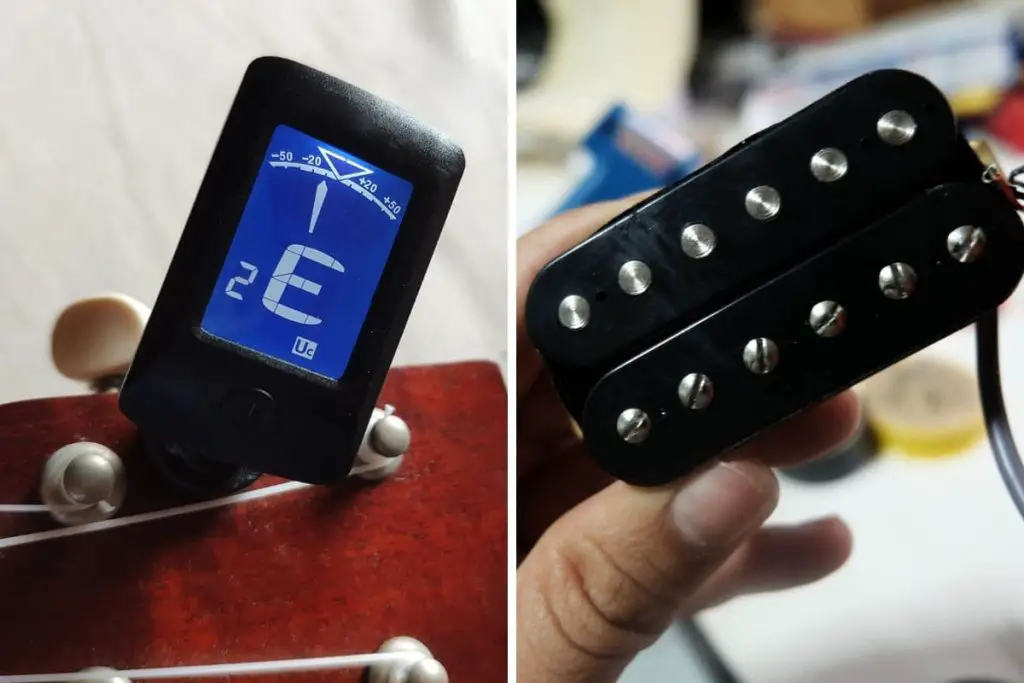
Tuners
Metal music is hardcore; we all know that. So purchasing tuners that will stay in place and maintain the key’s composure is critical! Locking tuners hold or lock the string’s tension in place to keep its tune. Metal guitarists would do well to install these tuners because the aggressive playing of metal can turn a guitar out of tune quite quickly.
Hipshot Chrome Tuners are a great set for those who don’t want to make many adjustments to the headstock of their guitar. Sometimes, locking tuners need to be drilled into place, but Hipshot tuners come with a mounting plate instead.
Pickups
Pickups sit on the body of the guitar, right beneath the strings, and metal guitarists will preach the word “humbucker” to anyone looking to make their guitar sound better for metal. Pickups transfer the vibration of the string into electricity. Humbucker pickups do that twice as well, producing a thicker sound– perfect for metal.
2. Use the Right Strings
Since the pick attack in metal is pretty gnarly, your guitar strings need to be durable. Interestingly, guitar strings are designed with thickness, coating, and material in mind, so naturally, some strings are better for metal music than others.
String Thickness
Guitar strings are made in five sizes, with most electric guitars using the thinnest one available. They’re called gauges, and they range from ‘super lightweight’ (the high E is .008 inches in thickness) to ‘heavy’ (the high E is .012 inches), with two sizes in between.
Most guitars use super lightweight to lightweight strings, but metal guitars should go for the medium to heavy size. When you’re ripping power chords in the thick of a metal show, you want to know that the strings of your instrument are capable of keeping up without snapping or wearing down over time.
A guide to the various gauges of guitar strings can be found here.
3. Adjust Your Amp Settings
Your amplifier likely has many different knobs and dials on it, and those knobs and dials are essential to make your electric guitar sound metal. Specifically, you want to look for the dials labeled gain (we know what that one is), treble, bass, mids, and EQ.
The gain dial controls the distortion level, so needless to say, you’ll want to ensure that it’s adjusted to the right setting. Most metal guitarists suggest turning the gain up to between eight and ten, depending on the type of amp you’re using.
The treble dial, also called the “presence” control on some amps, controls how defined your higher frequency riffs are. What this means is that depending on what your treble is set to, the mid to higher-pitched chords you play will sound either clear or fuzzy, lively or dull. Try the treble at seven to start; the sound should be sharp but not too overwhelming that it drowns out the vocals and other instruments.
On the flip side, the bass dial controls the low-end frequencies – your low notes will be emphasized big-time here. Most bass dials hover around eight in metal music, making your chords sound full and girthy.
The mids dial takes care of the middle frequencies in your music. Some musicians will argue that the best mids setting in metal music is scooped – meaning, the dial is set significantly lower than the treble and bass. Others will tell you that scooping your mids is the worst thing you can do for the overall quality of your music. Regardless, most metal guitarists will tell you to lower your mids dial to four to achieve the sound you’re looking for.
Finally, the EQ dial stands for an equalizer, balancing out your guitar’s tone by boosting or decreasing specific frequencies. An equalizer could make your treble stand out, show off your bass, or just make all the frequencies sound the same. Set your EQ to between three and four when you’re playing metal.
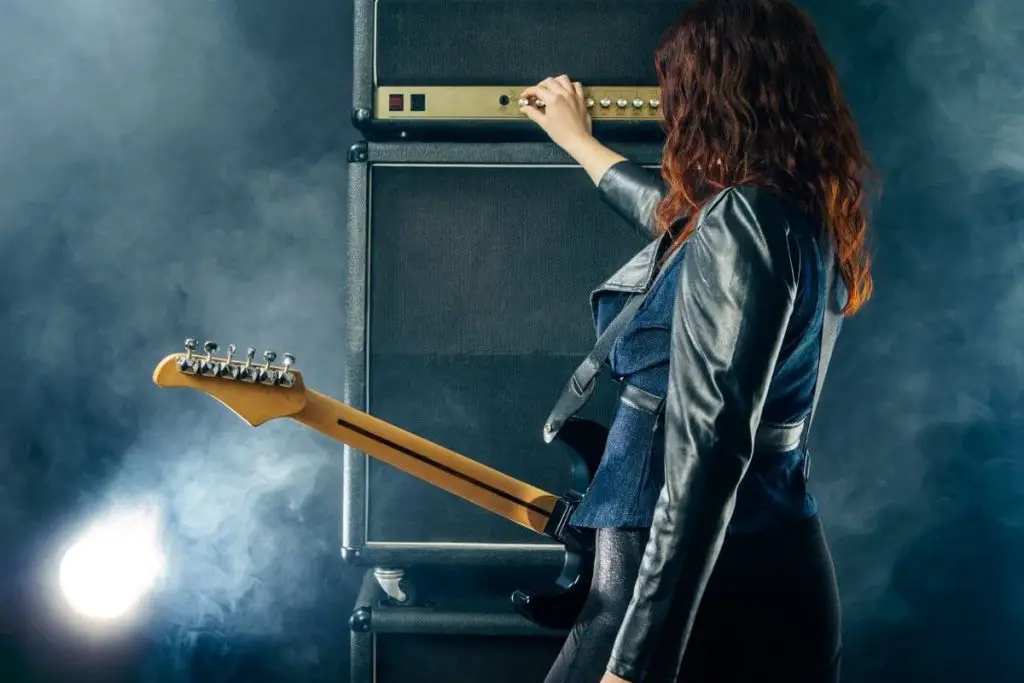
4. Use Pedals
Pedals are also a great tool to use when looking for a hard metal tone and can be used on top of amp adjustments. Some simple effects pedals you’ll want to consider are overdrive, compressor, and distortion pedals. While I do offer pedal suggestions, most guitar pedals will be sold at your local music store.
Compressor Pedal
A compressor pedal reduces the volume of loud tones while increasing the volume of quiet tones. While it’s not entirely necessary for metal, it will boost the sound quality and help maintain the instrument’s sustain (holding the length of a note long after it’s been released).
An ideal compressor pedal is the Keeley Compressor Plus (available on Amazon.com). It’s compact, simple, and accommodates both single coil and humbucker pickups, which is essential considering your guitar definitely has humbuckers… right?
Distortion Pedal
The name speaks for itself. A distortion pedal adds another layer of control on the amount of distortion you want for your guitar. These are perfect tools for those that have amplifiers without a gains dial but still want to achieve hardcore metal tones.
The Boss DS-1X (available on Amazon.com) is a hot pedal on the market right now. Built with durability in mind, it’s easy to use and produces an exceptional sound. Other pedals from the Boss series are just as well made, offering pedals for a variety of effects.
Overdrive Pedal
An overdrive pedal basically kicks the amp into overdrive– turning the volume high on an amp gives the music a unique effect. But, blasting the amp’s volume is sure to damage it over time, thus the need for a pedal that creates the same effect without the excessive volume.
Perhaps a little pricey, but the MXR Timmy pedal (available on Amazon.com) is super portable with a range of overdrive tones and definitely worth the money.
5. Practice the Right Techniques
Once you have the proper gadgets for the ultimate metal music, you’re set to start playing. However, metal isn’t just any type of rock genre – it requires the use of special techniques on the strings. Make sure you practice the proper metal techniques to produce the best sound! Metal guitarists use palm muting, sliding, shredding, and downstroke power chords when they play.
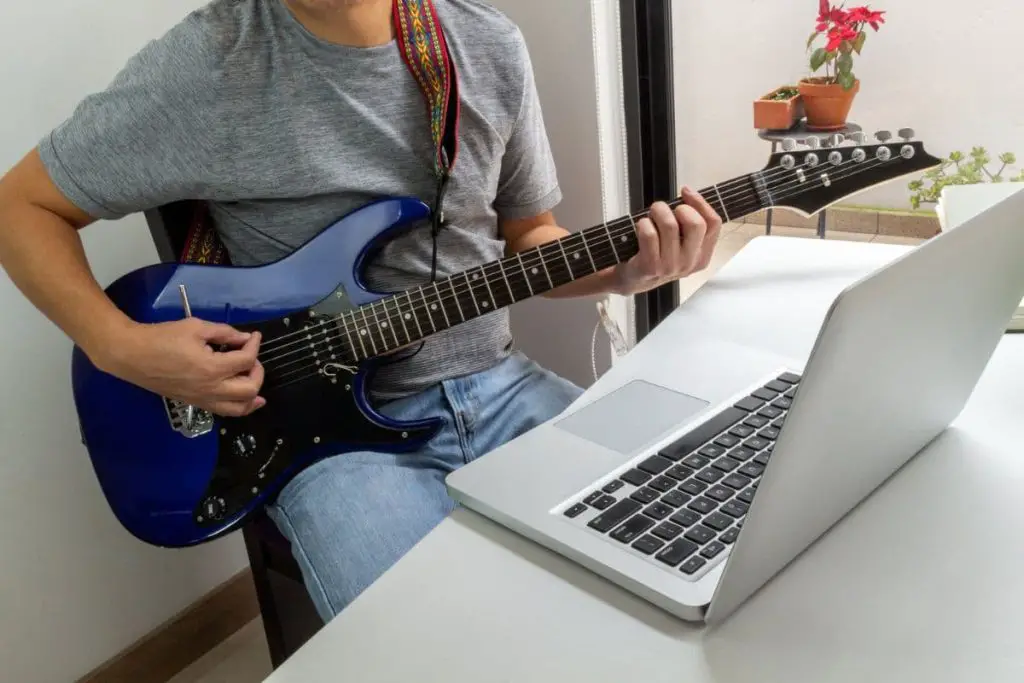
Palm Muting
Palm muting is a technique that is used by metal guitar players everywhere. It involves lying the lower outer edge of your palm against the strings of your guitar, which dampens them and creates a dull, muted sound.
When using this technique, rest your hand on the strings above the bridge, and don’t apply pressure. The name acts as a bit of a misnomer because you don’t want to stop the vibrations of the muted strings completely. The main idea is only to stifle them mildly. So, if you can’t strum the muted strings, that’s an indication you’re applying too much pressure.
Practice palm-muting by playing various power chords with your hand in a palm-muted position.
Sliding
Sliding on the guitar refers to playing a fretted note and then sliding your closed finger to a different fret on the neck. This makes traveling up or down a scale in a particular key audible. There are various ways to slide, all with one major thing in common: you must apply full pressure throughout. Without pressure, the slide will be unsuccessful, and you will lose the sound of the note.
Luckily, sliding is a straightforward thing to practice. Choose any string on the fretboard, close it, play it, and slide it up or down the scale.
Shred
Shredding is much more complex than sliding and requires significant dedicated practice. You’ll see why if you watch any epic metal guitarist shred (start with Ed Van Halen). Insanely fast-paced, shredding is a combination of advanced playing techniques such as tapping, sweeping and alternate picking.
Sweep Picking
Sweep picking is the act of strumming the strings in the same motion while your other hand frets each string individually and in sync. When your pick hits that low E, your other hand is fretting the E. When the pick moves on to A, your opposite hand is fretting the A. Coordination and speed are mandatory for this technique.
Tapping
Tapping is when a guitarist will use both hands to fret instead of picking with one and fretting with the other. Tapping and wiggling the string will produce sound, so it’s an effective technique to play multiple strings at a time.
Alternate Picking
Finally, alternate picking is picking strings in both upwards and downwards motions, alternating between the two. This makes playing one note fast, effortless, and feels incredibly natural to the player.
If you’re approaching advanced level playing and want to improve your metal, try practicing the techniques needed to shred by creating your own routine or following guitar lessons online!
Downstrokes and Power Chords
It’s worth it to mention that most metal is played with downstrokes and power chords. Downstrokes, when played with enough attack, hold excellent sustain. It also gives the music a more rigid, distinct sound. You should also do wrist warm-ups before practicing downstrokes, as it requires serious picking control.
A power chord consists of the first and fifth notes on a scale. For example, the first and fifth notes in an A major scale are A and E, so those two notes played together would be considered a power chord. Power chords are simple and straightforward, with other notes in the chord removed to reduce clashing sounds. Power chords are denoted on sheet music with a 5 in front of the key. Some common power chords are:
- C5: play the notes C and G
- B5: play the notes B and F sharp
- G5: play the notes D and G
- D5: play the notes A and D
Power chords can involve two or three strings. If a power chord has three strings, they’ll most likely be the first, third, and fifth notes or the first and third notes with the first string played twice. A three-string power chord is also called a triad.
Conclusion
To summarize, the right gear and the proper techniques are the two most important factors when you want to make your electric guitar sound better for metal. Guitars, strings, tuners, amps, and pedals are essential to the metal genre, so further research on the necessary equipment should be a priority.
Once you’re happy with your set-up, incorporate the above playing techniques into your practice regime, and get shredding.
In due time, your electric guitar will sound killer when you play metal music!
👇😀👇NOTE👇😀👇
If you want to find out what my recommended guitar gear is, then here is what I recommend on Amazon:
- Fender Cutaway Acoustic-Electric Guitar Bundle (MY FAVORITE GUITAR)
- Snark SN-8 Super Tight All Instrument Tuner (Easiest Tuner I’ve Used😏)
- 6 String Acoustic Guitar Capo (Best CAPO for quick changes)
- Dunlop Max Grip 1.0mm Nylon Picks (Thick Guitar Pick So You Don’t Lose Grip!)
- Universal Guitar Stand (Cheap & Minimalist Guitar Stand I Recommend)
- Levy’s 2″ Wide Quick Adjust Guitar Strap (Best Guitar Strap For Any Level)
Related Posts:
